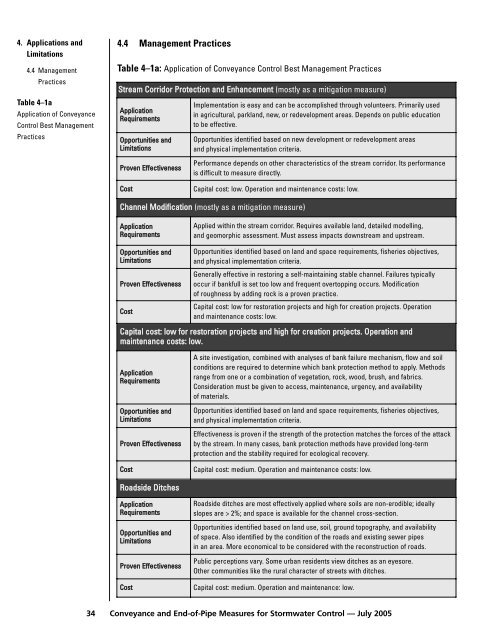Conveyance and End-of-Pipe Measures for Stormwater - FCM
Conveyance and End-of-Pipe Measures for Stormwater - FCM
Conveyance and End-of-Pipe Measures for Stormwater - FCM
Create successful ePaper yourself
Turn your PDF publications into a flip-book with our unique Google optimized e-Paper software.
4. Applications <strong>and</strong><br />
Limitations<br />
4.4 Management<br />
Practices<br />
Table 4–1a<br />
Application <strong>of</strong> <strong>Conveyance</strong><br />
Control Best Management<br />
Practices<br />
4.4 Management Practices<br />
Table 4–1a: Application <strong>of</strong> <strong>Conveyance</strong> Control Best Management Practices<br />
Stream Corridor Protection <strong>and</strong> Enhancement (mostly as a mitigation measure)<br />
Application<br />
Requirements<br />
Opportunities <strong>and</strong><br />
Limitations<br />
Proven Effectiveness<br />
Implementation is easy <strong>and</strong> can be accomplished through volunteers. Primarily used<br />
in agricultural, parkl<strong>and</strong>, new, or redevelopment areas. Depends on public education<br />
to be effective.<br />
Opportunities identified based on new development or redevelopment areas<br />
<strong>and</strong> physical implementation criteria.<br />
Per<strong>for</strong>mance depends on other characteristics <strong>of</strong> the stream corridor. Its per<strong>for</strong>mance<br />
is difficult to measure directly.<br />
Cost Capital cost: low. Operation <strong>and</strong> maintenance costs: low.<br />
Channel Modification (mostly as a mitigation measure)<br />
Application<br />
Requirements<br />
Opportunities <strong>and</strong><br />
Limitations<br />
Proven Effectiveness<br />
Cost<br />
Applied within the stream corridor. Requires available l<strong>and</strong>, detailed modelling,<br />
<strong>and</strong> geomorphic assessment. Must assess impacts downstream <strong>and</strong> upstream.<br />
Opportunities identified based on l<strong>and</strong> <strong>and</strong> space requirements, fisheries objectives,<br />
<strong>and</strong> physical implementation criteria.<br />
Generally effective in restoring a self-maintaining stable channel. Failures typically<br />
occur if bankfull is set too low <strong>and</strong> frequent overtopping occurs. Modification<br />
<strong>of</strong> roughness by adding rock is a proven practice.<br />
Capital cost: low <strong>for</strong> restoration projects <strong>and</strong> high <strong>for</strong> creation projects. Operation<br />
<strong>and</strong> maintenance costs: low.<br />
Capital cost: low <strong>for</strong> restoration projects <strong>and</strong> high <strong>for</strong> creation projects. Operation <strong>and</strong><br />
maintenance costs: low.<br />
Application<br />
Requirements<br />
Opportunities <strong>and</strong><br />
Limitations<br />
Proven Effectiveness<br />
A site investigation, combined with analyses <strong>of</strong> bank failure mechanism, flow <strong>and</strong> soil<br />
conditions are required to determine which bank protection method to apply. Methods<br />
range from one or a combination <strong>of</strong> vegetation, rock, wood, brush, <strong>and</strong> fabrics.<br />
Consideration must be given to access, maintenance, urgency, <strong>and</strong> availability<br />
<strong>of</strong> materials.<br />
Opportunities identified based on l<strong>and</strong> <strong>and</strong> space requirements, fisheries objectives,<br />
<strong>and</strong> physical implementation criteria.<br />
Effectiveness is proven if the strength <strong>of</strong> the protection matches the <strong>for</strong>ces <strong>of</strong> the attack<br />
by the stream. In many cases, bank protection methods have provided long-term<br />
protection <strong>and</strong> the stability required <strong>for</strong> ecological recovery.<br />
Cost Capital cost: medium. Operation <strong>and</strong> maintenance costs: low.<br />
Roadside Ditches<br />
Application<br />
Requirements<br />
Opportunities <strong>and</strong><br />
Limitations<br />
Proven Effectiveness<br />
Roadside ditches are most effectively applied where soils are non-erodible; ideally<br />
slopes are > 2%; <strong>and</strong> space is available <strong>for</strong> the channel cross-section.<br />
Opportunities identified based on l<strong>and</strong> use, soil, ground topography, <strong>and</strong> availability<br />
<strong>of</strong> space. Also identified by the condition <strong>of</strong> the roads <strong>and</strong> existing sewer pipes<br />
in an area. More economical to be considered with the reconstruction <strong>of</strong> roads.<br />
Public perceptions vary. Some urban residents view ditches as an eyesore.<br />
Other communities like the rural character <strong>of</strong> streets with ditches.<br />
Cost Capital cost: medium. Operation <strong>and</strong> maintenance: low.<br />
34 <strong>Conveyance</strong> <strong>and</strong> <strong>End</strong>-<strong>of</strong>-<strong>Pipe</strong> <strong>Measures</strong> <strong>for</strong> <strong>Stormwater</strong> Control — July 2005
















